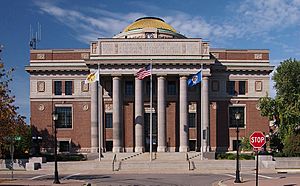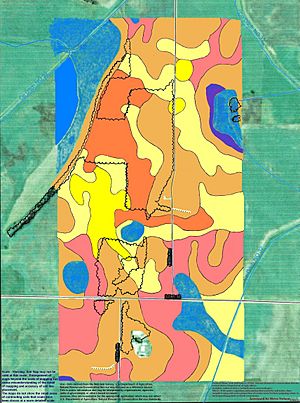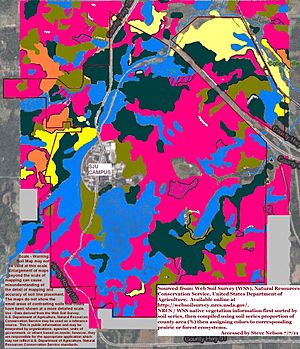Stearns County, Minnesota facts for kids
Quick facts for kids
Stearns County
|
|
|---|---|

|
|

Location within the U.S. state of Minnesota
|
|
 Minnesota's location within the U.S. |
|
| Country | |
| State | |
| Founded | February 20, 1855 |
| Named for | Charles Thomas Stearns |
| Seat | St. Cloud |
| Largest city | St. Cloud |
| Area | |
| • Total | 1,390 sq mi (3,600 km2) |
| • Land | 1,343 sq mi (3,480 km2) |
| • Water | 47 sq mi (120 km2) 3.4%% |
| Population
(2020)
|
|
| • Total | 158,292 |
| • Estimate
(2023)
|
160,977 |
| • Density | 113.9/sq mi (43.97/km2) |
| Time zone | UTC−6 (Central) |
| • Summer (DST) | UTC−5 (CDT) |
| Congressional districts | 6th, 7th |
Stearns County is a county located in the state of Minnesota, USA. In 2020, about 158,292 people lived here. The biggest city and the main government center is St. Cloud.
Stearns County became part of the Minnesota Territory in 1849. It was officially created by European Americans in 1855. The county was supposed to be named after Isaac Ingalls Stevens, but a mistake led to it being named after Charles Thomas Stearns instead. Stearns County is part of the larger St. Cloud Metropolitan Area. This area is also connected to the Minneapolis-St. Paul area.
Contents
History of Stearns County
Long ago, different Native American tribes lived in the Stearns County area. These included the Sioux (Dakota), Chippewa (Ojibwe), and Winnebago (Ho-chunk) peoples.
The first large group of new settlers arrived in the 1850s. Many of these were German Catholics. Other early settlers came from states in the eastern U.S. The federal government created the Minnesota Territory in 1849.
How Stearns County Was Formed
In 1855, parts of other counties were used to create Stearns County. It was meant to be named Stevens County. This was to honor Isaac Ingalls Stevens, who was the governor of the territory. He had explored the area in 1853.
However, because of a small mistake, the county was named Stearns instead. It was named after Charles Thomas Stearns, who was a member of the Territorial Council. Later, another county to the west was named Stevens County to fix this mistake.
On February 20, 1855, the law that created Stearns County also named three county commissioners. These officials were in charge of running the county. The law also said that St. Cloud would be the county seat. This means St. Cloud is where the county's main government offices are located.
German Catholic Settlers
Many German Catholic immigrants came to central Minnesota in the 1850s. A missionary named Father Francis X. Pierz encouraged them to settle there. He wrote articles in German newspapers.
These immigrants, along with some from Slovenia and Poland, built many churches. Over 20 church-centered communities were formed in Stearns County. As farmers became successful, they replaced their small wooden churches with bigger ones made of brick or stone. An example is St. Mary, Help of Christians, built in 1873.
Stearns County still has a strong German heritage. It is home to one of the largest groups of rural Catholic people in North America.
County Buildings and Farming
The first courthouse in Stearns County started being used on July 12, 1864. It was used until the current courthouse was built in 1922. In 1913, some people tried to move the county seat to Albany. They thought Albany was a better location because it was more central. However, this effort was not successful.
Stearns County also became important for its farms. Farmers grew many crops and traded them at markets. This made Stearns County one of the top counties in Minnesota for crop production.
Geography of Stearns County
Stearns County shares its borders with nine other counties. The Mississippi River flows along its northeast edge. The Sauk River flows through the middle of the county and joins the Mississippi River at St. Cloud.
The county's land has gentle, rolling hills. It has some trees, many lakes, and ponds. Almost all the land is used for farming or has been built on. The land gently slopes towards the east and south. The highest point is about 1,461 feet (445 meters) above sea level. This spot is west and south of St. Joseph.
Stearns County covers about 1,390 square miles (3,600 square kilometers) in total. About 1,343 square miles (3,478 square kilometers) is land, and 47 square miles (122 square kilometers) is water. This means about 3.4% of the county is water.
The county has a mix of landscapes, including prairies (grassy lands), savannas (grassy lands with scattered trees), and woodlands. Stearns is one of 17 counties in Minnesota that has more savanna soils than prairie or forest soils. There are 166 lakes in the county.
Major Roads
 Interstate 94
Interstate 94 U.S. Highway 52
U.S. Highway 52 U.S. Highway 71
U.S. Highway 71 Minnesota State Highway 4
Minnesota State Highway 4 Minnesota State Highway 15
Minnesota State Highway 15 Minnesota State Highway 22
Minnesota State Highway 22 Minnesota State Highway 23
Minnesota State Highway 23 Minnesota State Highway 24
Minnesota State Highway 24 Minnesota State Highway 28
Minnesota State Highway 28 Minnesota State Highway 55
Minnesota State Highway 55 Minnesota State Highway 237
Minnesota State Highway 237 Minnesota State Highway 238
Minnesota State Highway 238- List of county roads
Airports in Stearns County
- Brooten Municipal Airport (6D1) - near Brooten
- Paynesville Municipal Airport (PEX) - near Paynesville
- Sauk Centre Municipal Airport (D39) - near Sauk Centre
- St. Cloud Regional Airport (STC) - near St. Cloud
Counties Next to Stearns County
- Todd County - north
- Morrison County - northeast
- Benton County - northeast
- Sherburne County - east
- Wright County - southeast
- Meeker County - south
- Kandiyohi County - southwest
- Pope County - west
- Douglas County - northwest
Protected Natural Areas
Stearns County has many protected areas where nature is preserved. These include:
- Avon Hills Forest Scientific and Natural Area
- Birch Lakes State Forest
- Christopher Kurilla Wildlife Management Area
- Cold Spring Heron Colony Scientific and Natural Area
- Crow River Wildlife Management Area
- Edward Raymond Mohs Wildlife Management Area
- Follies Wildlife Management Area (part)
- Lake Koronis Regional Park
- Legacy Marsh Wildlife Management Area
- Miller Wildlife Management Area
- Milton Kjedahl Wildlife Management Area
- Norman T. Dahlman Wildlife Management Area
- Oxcart Crossing Wildlife Management Area
- Padua State Wildlife Management Area
- Patch Woods Scientific and Natural Area
- Quarry Park and Nature Preserve
- Quarry Park Scientific and Natural Area
- Rockville County Park and Nature Preserve
- Roscoe Prairie Scientific and Natural Area
- Saint Wendel Tamarack Bog Scientific and Natural Area
- Sauk River Wildlife Management Area
- Sedan Brook Prairie Scientific and Natural Area
- Stearns Prairie Heritage Wildlife Management Area
- Tamarack State Wildlife Management Area
- Tower State Wildlife Management Area
- Tribute Wildlife Management Area
- Victor Winder Wildlife Management Area
- Warner Lake County Park
- Zion State Wildlife Management Area
Lakes and Streams
- Adley Creek
- Crow Lake
Who Lives in Stearns County? (Demographics)
Demographics is the study of who lives in a place. It looks at things like population size and different groups of people.
| Historical population | |||
|---|---|---|---|
| Census | Pop. | %± | |
| 1860 | 4,505 | — | |
| 1870 | 14,206 | 215.3% | |
| 1880 | 21,956 | 54.6% | |
| 1890 | 34,844 | 58.7% | |
| 1900 | 44,464 | 27.6% | |
| 1910 | 47,733 | 7.4% | |
| 1920 | 55,741 | 16.8% | |
| 1930 | 62,121 | 11.4% | |
| 1940 | 67,200 | 8.2% | |
| 1950 | 70,681 | 5.2% | |
| 1960 | 80,345 | 13.7% | |
| 1970 | 95,400 | 18.7% | |
| 1980 | 108,161 | 13.4% | |
| 1990 | 118,791 | 9.8% | |
| 2000 | 133,166 | 12.1% | |
| 2010 | 150,642 | 13.1% | |
| 2020 | 158,292 | 5.1% | |
| 2023 (est.) | 160,977 | 6.9% | |
| U.S. Decennial Census 1790-1960 1900-1990 1990-2000 2010-2020 |
|||
2020 Census Information
The table below shows the different groups of people living in Stearns County, based on the 2020 U.S. Census. "NH" means "Non-Hispanic." This helps to show how many people from different backgrounds live in the county.
| Race / Ethnicity | Pop 2010 | Pop 2020 | % 2010 | % 2020 |
|---|---|---|---|---|
| White alone (NH) | 136,414 | 129,276 | 90.56% | 81.67% |
| Black or African American alone (NH) | 4,595 | 13,224 | 3.05% | 8.35% |
| Native American or Alaska Native alone (NH) | 392 | 439 | 0.26% | 0.28% |
| Asian alone (NH) | 2,949 | 3,159 | 1.96% | 2.00% |
| Pacific Islander alone (NH) | 38 | 61 | 0.03% | 0.04% |
| Some Other Race alone (NH) | 107 | 435 | 0.07% | 0.28% |
| Mixed Race/Multi-Racial (NH) | 1,957 | 4,747 | 1.30% | 3.00% |
| Hispanic or Latino (any race) | 4,190 | 6,951 | 2.78% | 4.39% |
| Total | 150,642 | 158,292 | 100.00% | 100.00% |
Note: The U.S. Census counts Hispanic/Latino people as an ethnic group. This table separates them from the racial groups. Hispanic/Latino people can be of any race.
Communities in Stearns County
Stearns County has many different towns and cities. Here are some of them:
Cities
- Albany
- Avon
- Belgrade
- Brooten (part)
- Clearwater (part)
- Cold Spring
- Eden Valley (part)
- Elrosa
- Freeport
- Greenwald
- Holdingford
- Kimball
- Lake Henry
- Meire Grove
- Melrose
- New Munich
- Paynesville
- Richmond
- Rockville
- Roscoe
- Saint Anthony
- Saint Augusta
- Saint Cloud (county seat; partial)
- Saint Joseph
- Saint Martin
- Saint Rosa
- Saint Stephen
- Sartell (part)
- Sauk Centre
- Spring Hill
- Waite Park
Census-Designated Places
These are areas that are like towns but are not officially incorporated as cities.
- Fairhaven
- St. John's University
Unincorporated Communities
These are small communities that do not have their own local government.
Townships
Townships are smaller areas of land, often rural, that have some local government.
- Albany Township
- Ashley Township
- Avon Township
- Brockway Township
- Collegeville Township
- Crow Lake Township
- Crow River Township
- Eden Lake Township
- Fair Haven Township
- Farming Township
- Getty Township
- Grove Township
- Holding Township
- Krain Township
- Lake George Township
- Lake Henry Township
- Le Sauk Township
- Luxemburg Township
- Lynden Township
- Maine Prairie Township
- Melrose Township
- Millwood Township
- Munson Township
- North Fork Township
- Oak Township
- Paynesville Township
- Raymond Township
- Saint Joseph Township
- Saint Martin Township
- Saint Wendel Township
- Sauk Centre Township
- Spring Hill Township
- Wakefield Township
- Zion Township
See also
 In Spanish: Condado de Stearns para niños
In Spanish: Condado de Stearns para niños



